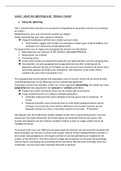Lampel & Germain (2016): Creative industries as hubs of new
organizational and business practices
Introduction
Creative industries can be seen as hubs of managerial innovation and experimentation. One
can look at creative industries as pioneers of managerial and organizational practices.
Creative industries are more likely than ever before to exercise influence on management
thinking across a wide range of industries.
The following themes are important to understand how creative industries influence
practices of other industries.
Creative industries as celebrity industries
Much as individuals can attain a celebrity status, so can firms. The authors define
- ‘celebrity firms’ as those firms that attract a high level of public attention and
generate positive emotional responses from stakeholder audiences.
Organizations such as the Metropolitan Opera, Disney, the Bolshoi Ballet, and the Cannes
Film Festival, attract high level of public attention, and generate positive response from
stakeholder audiences. In part this is because there is often a close relationship between
celebrities and celebrity organizations.
Unlike other industries creative industries rely on creative individuals that are often
considered to have unique talent, and creative processes that are mysterious if not
inexplicable to outsiders. Today it is possible to see the same in the venture capital industry.
The industry's star firms and star investors confer star status on the firms they back using
processes that are mysterious to outsiders, and arguably even to themselves.
Value chain transformation in the creative industries
Industries have been shifting from vertically integrated to an era of value chain
fragmentation. Generally speaking, market institutions evolve and mature industries find it
easier to specify and enforce contracts. Transaction costs will then decline, and with it,
there will be a corresponding incentive to outsource internal activities. However, the
difficulty, as many firms, including the Ford Motor company found out, is making the
transition from vertical integration to flexible production.
Fordism never took hold in the creative industries. One can point to Hollywood in the 1920s
and 1930s as the most significant exception, but even here the attempt to vertically
integrate operations ran into difficulties and was eventually abandoned. The key challenge
in creative industries is recruiting creative resources, and then coordinating these resources
into products that generate supernormal rents.
1
,In many industries the difficulties of efficiently contracting key resource inputs lead to
backward vertical integration. Firms in the creative industries are generally reluctant to
pursue backward vertical integration, largely because they find it very difficult to write
enforceable contracts with talent. Two ways to deal with that: in
- ‘transactional governance’, companies are drafting contracts that set objectives, and
pre-specify in detail the interaction process.
- ‘relational governance’ which relies on trust and mutual understanding that is
reinforced by repeated interaction. Relational governance was, and is, pervasive in
the creative industries because transactional governance which requires contracts
that specify and price deliverables in advance, is ill suited to innovation.
Furthermore, innovation is often co-created between organizations. Trust and open
communication facilitates co- creation of innovation, pointing to relational governance as
the better mode of interaction. Ultimately, relational governance is more powerful in
creative industries because
- firms seek to maximize transaction value—that is, the generation of value through
interdependent complementarities—more than minimizing transaction costs.
Creative industries and the experience economy
The influence that creative industries exercise on managerial thinking is the rise of the so
called ‘experience economy’. The experience economy upended many of our traditional
ideas of how consumers evaluate products. Our economy has entered a stage of economic
development where experience increasingly dominates consumption. Implicitly, this means
that
- the utilitarian, or use value, of a product plays a decreasing role in competition, and
creating experience is becoming progressively more important.
The rise of the experience economy also changed the understanding of what constitutes a
“product”. Previously, producers and consumers in most consumer and industrial markets
tended to see products as discrete with clearly marked boundaries. Creative industries were
an exception. In these industries product boundaries are far more fluid. The blurring of the
distinctions between products categories grows stronger as the experience economy
migrates to online platforms where the relationship between consumers and creative
products is increasingly shaped by aggregators such as YouTube, Netflix, and Spotify.
Creative industries and the enterprising of self
People working in creative industries are willing to forego adequate remuneration is in part
due to the intrinsic rewards of creative work, and to some extent it is due to optimism based
on the highly publicized instances where new entrants achieve high position and exceptional
pay packets. The war for talent became a permanent feature of creative industries before it
spread to other industries. This persistence against long odds suggests that
2
, - creative individuals in the creative industries are taking on many of the
characteristics usually associated with entrepreneurs rather than employees.
Taken to its logical conclusion this means that they are more likely to develop an
entrepreneurial mindset which involves risk taking, and requires a willingness to brand the
self as the inevitable price that has to be paid to achieve market success.
The creative individual, economically precarious but emotionally autonomous, therefore
becomes a powerful symbol of entrepreneurial identity, reinforcing the increasingly popular
attempts by many organizations to construct ideologies that emphasize commitment and
innovative behaviors within unstable contexts.
Conclusion
For management scholars, on the other hand, creative industries are of considerable
interest in part because they embody many of the characteristics of post-industrial
economy: flexible organizing, advanced use of technologies in the production process,
innovation that relies on questioning of established logics, and extensive employment of
creative and technical talent.
By the same token, the dilemmas that creative industries have had to deal with for many
decades: the management of talent, the strategic use of intangibles, the balancing of
idiosyncratic individuals with team cohesion, and the reliance on networks, are now
common in many industries. The practices that creative industries developed to deal with
these dilemmas also apply to many other industries where some, or all, of these conditions
prevail.
FROM SLIDES:
Creative industries help for:
strategic use of intangibles
innovation that relies on questioning of established
logics & categories
the management of talent
the balancing of idiosyncratic individuals with team cohesion
the reliance on networks, inside & outside the organization
Research method
Summary of various papers that were submitted and handle the previously discussed key
issues that creative industries possess.
3
, Velthuis (2003): Symbolic Meanings of Prices: Constructing the Value of
Contemporary Art in Amsterdam and New York Galleries
This article develops a sociological analysis of the pricing mechanism. The overarching
argument is that
- pricing is not just economic, but also a signifying act; in other words, the author
interprets the price mechanism as a symbolic system.
Despite the impersonal, businesslike connotations of prices, the author argues that actors in
markets manage to express a range of cognitive and cultural meanings.
The aim of this article is to address two major anomalies of the price mechanism on the
market for contemporary art that follow from the application of specific pricing norms. The
author shows that prices are not set on a case-by-case basis, but result instead from
conventions of setting prices that are shared by art dealers and their transaction partners
(“institutional isomorphism”).
The first norm he discusses is
- the avoidance of price decreases at all times.
From an economic perspective, this norm seems anomalous, because dealers ignore the
concept of price elasticity and behave more like price maximizers than like profit
maximizers. The second norm is to
- avoid pricing artworks of the same size within the oeuvre of an artist differently, even
if art dealers know that some works are easier to sell than others.
This means that dealers fail to differentiate prices according to either quality or demand.
Apart from contributing to the analysis of prices within economic sociology, his argument
builds on literature in the sociology of the arts, which states that aesthetic, artistic, or
cultural values are socially constructed, and that the appreciation of an artwork is
dependent on the social context in which it is seen. In particular, the value of an artwork
does not reside in the work itself, but is produced and constantly reproduced by the artist,
intermediaries, and the audience.
Symbolic meanings of prices constitute, in other words, an intimate connection between
price and cultural value.
In contemporary art there is NO price elasticity like in economic theory.
First of all, price signals do not just serve the economic purpose of making sales to collectors
or maximizing productivity of artists. As the author shows:
a) meanings of prices and price changes prompt dealers to enact their multiple roles of
gatekeepers, confidants and patrons of artists
4










